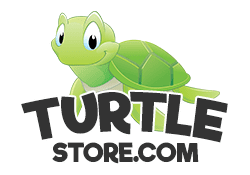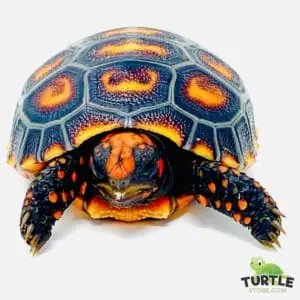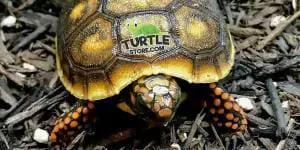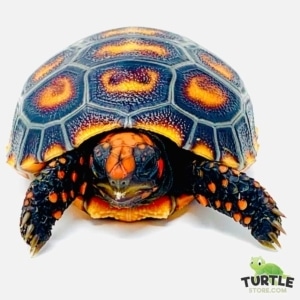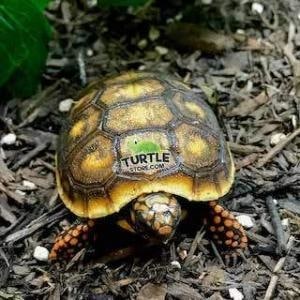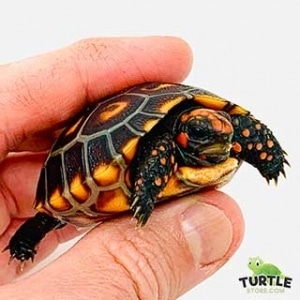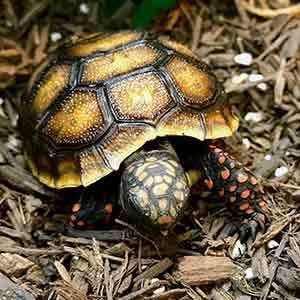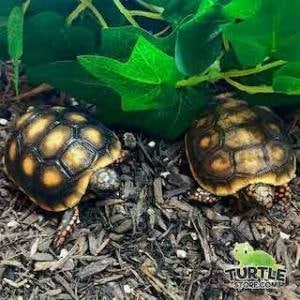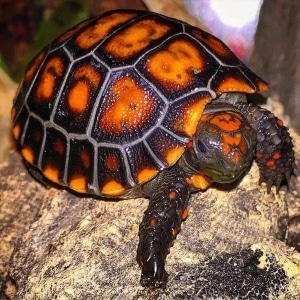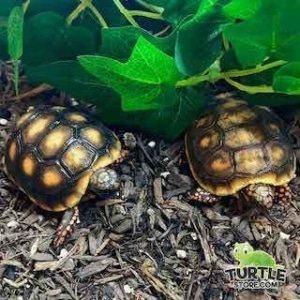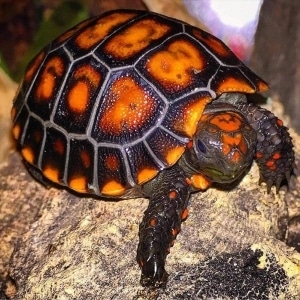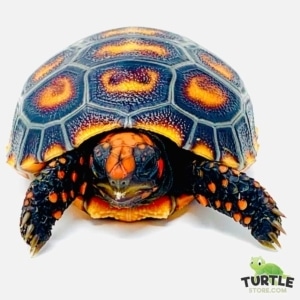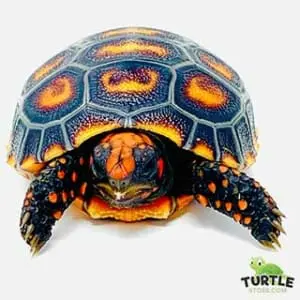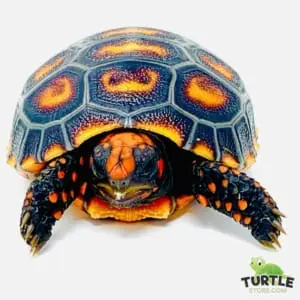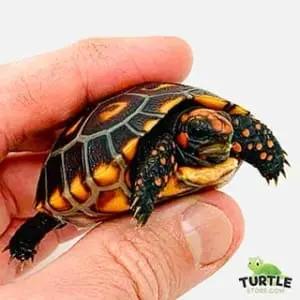Red Foot Tortoise Lighting
The temperature should be considered when purchasing, building or setting up a habitat for your new red footed tortoise. Temperature is very important in ant type of tortoise habitat. Tortoises are cold-blooded so they need help thermoregulating.
Red foot tortoise thermal gradient in habitat
Cool and hot zones in your red foot tortoise habitat can balance their internal body temperature. A basking lamp can be used on one end. We recommend a 100-500 watt mercury-vapor lamp and keeping a hot spot at about 95 degrees.
Although providing a hotspot is the main focus, lighting also has the potential to produce heat. A heat lamp or heat emitter runs at the same time as the lights. UV lights are necessary for UVB and UVA. We recommend T5 high output fixtures.
Red Foot Tortoise Care
Red foot tortoises are some of the easiest to care for of all tortoise species. Like any other reptile, they require research to ensure you are able to give them the best care and life possible. One of the most hardy tortoise for sale in the world, the red foot tortoise is the perfect pet for all pet owners, no matter how much experience they have. A baby red foot tortoise will grow to sizes of 14″ and up to 20 lbs when they reach adulthood. Keep this in mind when deciding if you are building or purchasing a temporary or permanent habitat.
Our biologist has compiled a fantastic red foot tortoise care guide. Please be sure to view all aspects of caring for your new Sulcata at the pages below:
- Baby red foot tortoise
- Red footed tortoise habitat
- Red footed tortoise temperature
- red footed tortoise Lighting
- red footed tortoise substrate
- red footed tortoise food
- red footed tortoise diet
- red footed tortoise humidity
- red footed tortoise lifespan
- red footed tortoise size
- red footed a tortoise for sale
- red footed tortoise appearance
- cherry head red foot tortoise
- red foot tortoise
Red foot Tortoise Diet
Redfoot tortoises are herbivores. They enjoy eating dark leafy greens. Some examples include mustard greens, collard greens, kale, red leaf lettuce and carrot tops. Like many other tortoises, they require more nutrition than just lettuce. They can eat their daily vitamins through pellets such as Mazuri. Their food should be dusted with calcium about every other day.
Red footed tortoise Lifespan
Red footed tortoises live to be about 50 years old! For this reason, consider the length of the time you will spend with your new shelled friend.
Red foot Tortoise Habitat and Housing:
Red foot tortoises require large housing due to their size. For this reason, housing them indoors is difficult sometimes. This must be considered before purchasing. Here at Turtle Store, we believe a tortoise table is the best choice of habitat for red foots.
We offer a full complete tortoise habitat kit, available here. A reasonable size for a hatchling is 2 foot by 2 foot, however, hatchlings will outgrow this very quickly. We recommend purchasing this before purchasing a baby red foot tortoise for sale.
Red foot tortoise humidity
Red foot tortoises need the proper humidity. Reptile foggers can help accomplish this. To make it easier, you can plug it in at the same time as your lighting system. The fogger should be run every morning to give them a humid phase but to also allow for a dry phase at night.
Until they reach 18 months old, a baby red foot tortoise enclosure should have a humidity of 65%. The enclosures humidity can be maintained by spraying down your substrate four times a day or by using a reptile fogging system.
Soaking your baby red foot tortoise daily
Soaking your baby red foot tortoise should be part of your daily routine. It should be soaked for about ten minutes every day. Make sure the water is not too low that they can not drink it but that it is also not too high that the dangers of drowning it arise. Soaking your tortoise ensures proper hydration and humidity. Humidity should be kept around 65%. Proper humidity allows for the growth of smooth shells. Dry habitats decrease the health and well being of the tortoise. Pyramiding is the result of a tortoise kept in too low of a humidity.
Red footed tortoise Habitat size
The habitat must grow with the tortoise. Water dishes and food trays can be made more easily accessible by cutting holes at the bottom so they sink lower. The water dish in a red foot tortoise habitat should be large enough for the tortoise to have a proper soak. Make sure the water is not deep enough for the tortoise to drown though. Red foot tortoises should have at least an 8×8 ft habitat. As for housing adults, an outdoor enclosure or heated shed is always the better option is weather allows it.
Red foot tortoise substrate
An important part of any tortoise habitat is the substrate. Substrate allows for digging and in turn thermoregulation. The right substrate also allows for proper humidity percentages. At TurtleStore.com, we recommend using a mixture of potting mix, play sand, and cypress mulch. Proper humidity levels can be kept by spraying down the substrate with water daily.
Coco core, soil and reptile bark type substrates are alternatives that work just as well. Just be sure that whatever you purchase is safe for reptiles meaning it is not treated with anything including fertilizers and other chemical contaminants.
Red foot tortoise Size:
The red foot tortoise is a medium sized species. They can grow up to 14 inches in length but often reach 11 inches at adulthood. Males are larger than females.
Red footed tortoise Appearance:
Red foot tortoises for sale shells are a uniform brown. The bumps on the tops of their shells are often bright red and or orange. Their heads may have red marks at the top. Patches of orange, red and yellow often appear on their legs and tail.
Male red foot tortoises are almost always bigger than their female counterparts. Adult male red foot tortoises have a deeply concave plastron. Female red footed tortoises have a more rounded appearance.
Shell rotting or non-responsive and lethargic tendencies could be a sign of an ill tortoise.
Red foot tortoises graze when it’s warm
Red foot tortoises enjoy roaming outside when it is hot. This must be in an enclosed environment of course. They benefit from being outdoors because of their large size and grazing habits. Shade, hiding spots and water must be provided in this outdoor habitat for your baby red foot tortoise. Daytime temperatures can be up to 100 F and nighttime temperatures should not drop below 70 degrees F.
A shallow dish of water should be provided at all times.
More than just baby red foot tortoises for sale
We also have baby cherry head red foot tortoises in stock. Cherry heads are a fascinating species. With their bright colors, they are highly sought after. Cherry head red foot tortoises are generally smaller than red foot tortoises. They are a hardy species.
The turtle store is your source for the largest selection of captive bred baby tortoise for sale and adult tortoise for sale. All of our captive bred baby tortoises come with our full live arrival and health guarantee. Here at the turtle store, we work with over 25 species of turtles for sale including baby turtles for sale and captive bred tortoises. The turtle store guarantees you the largest selection of healthy, captive bred turtles and tortoise for sale anywhere in the USA.
